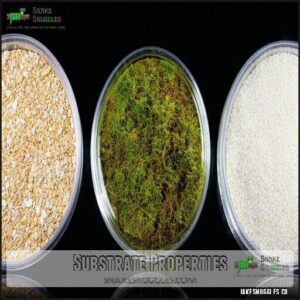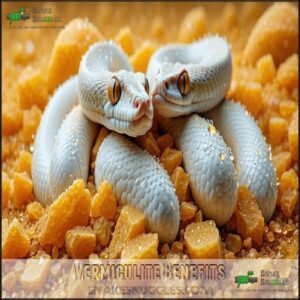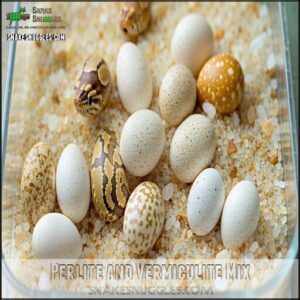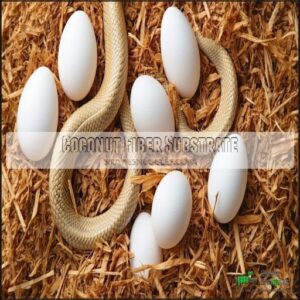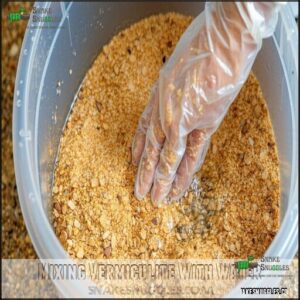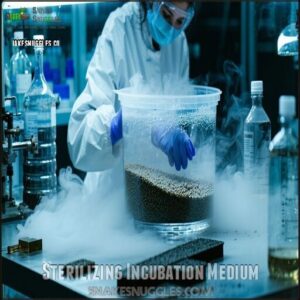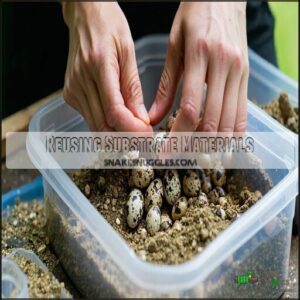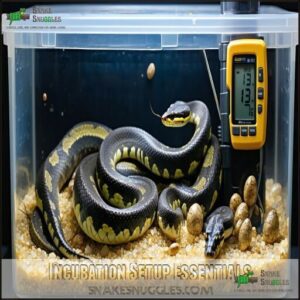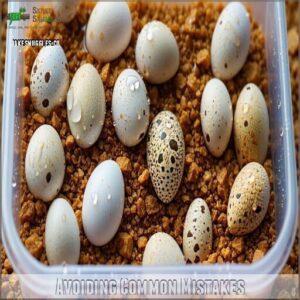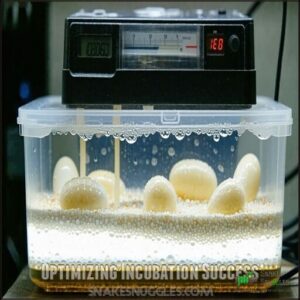This site is supported by our readers. We may earn a commission, at no cost to you, if you purchase through links.
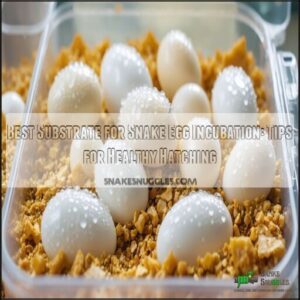 The best substrate for snake egg incubation is one that retains moisture, provides aeration, and guarantees a stable environment for developing embryos.
The best substrate for snake egg incubation is one that retains moisture, provides aeration, and guarantees a stable environment for developing embryos.
Vermiculite is a popular choice because it holds water well and doesn’t compact, allowing oxygen flow. Perlite, another great option, is lightweight and mold-resistant.
Many breeders prefer a 1:1 vermiculite-to-water ratio by weight, creating a moist (not soggy) medium. Whichever you choose, consistency matters—maintain humidity around 90% and handle eggs gently to avoid damaging embryos.
Don’t forget to check temperature regularly; a slight fluctuation can mean a world of difference. Curious about ideal setups? There’s more to explore, and maintaining the right conditions is crucial for a successful incubation, which requires careful handling to ensure the embryos develop in a healthy environment.
Table Of Contents
- Key Takeaways
- Choosing Incubation Medium
- Incubation Environment Factors
- Substrate Properties
- Safe Substrate Options
- Substrate Preparation Methods
- Incubation Setup Essentials
- Snake Egg Care Techniques
- Humidity Control Strategies
- Avoiding Common Mistakes
- Optimizing Incubation Success
- Frequently Asked Questions (FAQs)
- How do you keep a snake safe during egg incubation?
- What should you use as a substrate in a snake incubator?
- How to incubate snake eggs?
- Do you need a moisture meter for snake egg incubation?
- Do snake eggs need an incubator?
- What humidity do milk snake eggs incubate?
- What is the substrate for incubation eggs?
- What do you use to incubate snake eggs?
- What is the best substrate for reptile incubation?
- What is the best substrate for baby snakes?
- Conclusion
Key Takeaways
- Vermiculite is your best substrate choice for snake egg incubation as it provides excellent moisture retention without compacting, allowing proper oxygen flow with a recommended 1:1 vermiculite-to-water ratio by weight for optimal humidity levels around 90%.
- You’ll need to maintain stable temperature (88-89°F for most species) and proper ventilation throughout incubation, as even slight fluctuations can harm developing embryos and promote dangerous mold growth.
- When handling eggs, always mark their position and avoid rotation, as flipping eggs damages the developing embryos—use candling techniques to monitor development and viability throughout incubation.
- You can also consider alternatives like perlite (excellent for aeration and mold resistance) or coconut fiber, but whichever substrate you choose, ensure it’s properly sterilized before use to prevent contamination.
Choosing Incubation Medium
Choosing the right incubation medium is essential for maintaining proper humidity and ensuring healthy embryo development.
The right incubation medium ensures stable humidity and supports healthy embryo development, paving the way for successful hatching.
By selecting a substrate like vermiculite or perlite, you’ll provide ideal moisture retention and gas exchange for successful hatching.
Selecting Perlite or Vermiculite
When choosing between perlite and vermiculite for a reptile egg substrate, consider their origins and properties.
Vermiculite, made from expanded mica, offers excellent water absorption, ideal for substrate moisture levels.
Perlite, derived from volcanic rock, provides aeration without breaking down.
Cost comparison shows both are affordable, but species-specific needs dictate the best incubation medium.
Both work well for reptile eggs.
Benefits of Vermiculite
Vermiculite is a top choice for snake egg incubation due to its excellent moisture retention, wide availability, and mineral composition, which makes it inert and safe.
It’s cost-effective and simple to use—just mix with water in a 1:1 ratio for best results.
This reptile egg substrate is ideal for maintaining stable humidity, ensuring healthy embryo development and is a key factor in stable humidity.
Benefits of Perlite
Perlite, a lightweight material of volcanic origin, offers excellent moisture retention without breaking down.
Its porous texture guarantees stable humidity levels, keeping eggs hydrated yet safe from waterlogging.
As an alternative substrate for reptile eggs, perlite is reliable for consistent incubation. By holding water efficiently, perlite for eggs maintains the delicate balance between air and moisture, essential for healthy embryo development.
Incubation Environment Factors
To guarantee healthy hatching, you’ll need to maintain precise control over temperature, humidity, and ventilation.
These factors create a stable environment that supports proper egg development while preventing issues like mold or dehydration.
Temperature Control
Getting temperature control right is essential for egg incubation.
Aim for an ideal temperature of 88-89°F for most snake species.
Use these tips:
- Calibrate thermometers regularly for accuracy.
- Avoid temperature fluctuations with a reliable thermostat.
- Confirm even heating with heat tape or pads.
- Place eggs away from heating elements.
- Use cooling strategies like ventilation in warm climates to achieve the desired temperature range for successful egg incubation.
Humidity Levels
Monitoring humidity is essential for reptile egg incubation.
Keep humidity around 90% for snake eggs, as low levels cause egg dimpling, signaling moisture retention issues.
Adjust the substrate’s water content carefully to prevent mold while maintaining ideal reptile egg humidity.
Regular humidity monitoring helps identify species-specific needs, ensuring healthy incubation.
Proper balance prevents issues like mold and supports successful hatching.
Ventilation Importance
Proper ventilation guarantees air circulation, supporting gas exchange essential for embryo health.
Without it, stagnant air can encourage mold, harming eggs. Porous substrates help balance humidity while preventing excess moisture buildup.
Always check that your setup allows for fresh air flow—an incubator isn’t a sealed jar!
Ventilation plays a key role in maintaining ideal conditions for successful hatching, which is crucial for embryo health.
Substrate Properties
Understanding the properties of your incubation substrate is key to maintaining healthy snake eggs.
You’ll need a material that retains moisture, allows proper gas exchange, and remains chemically stable to create the ideal environment for developing embryos, which is crucial for the healthy development of the snakes.
Moisture Retention
A well-hydrated incubation medium is key for moisture retention without waterlogging.
Avoid condensation risks by achieving proper substrate saturation. Vermiculite excels at holding water, supporting a steady humidity gradient.
Follow these steps to optimize substrate hydration:
- Measure water-to-substrate ratio.
- Mix gently for even moisture.
- Avoid puddles or dryness.
- Check humidity regularly.
- Add water sparingly if needed.
The goal is to achieve proper substrate saturation and maintain it, ensuring the best conditions for incubation.
Porosity and Aeration
While moisture retention supports humidity, porosity guarantees proper gas exchange.
A substrate with good aeration allows oxygen in and carbon dioxide out, preventing stagnation. Substrate density matters—too compact, and airflow suffers.
With proper ventilation, porous materials like vermiculite or perlite optimize oxygen availability.
It’s like fresh air for eggs, supporting healthy development and reducing risks. Simple yet indispensable for hatching success!
Inertness and Safety
Understanding porosity naturally leads to inertness—the backbone of substrate safety.
An inert substrate prevents unwanted reactions like chemical leaching or toxin absorption. Avoid materials prone to mold or bacterial growth to keep eggs unharmed.
Some substrates, like reptile soil substrate, also promote healthy shedding.
Good choices include:
- Vermiculite: Moisture-friendly, minimal material degradation.
- Perlite: Clean, resists contamination.
- Coconut fiber: Safe, mold-resistant.
- HatchRite: Pre-sterilized, contamination-free.
Safe Substrate Options
Choosing the right substrate is vital to guarantee your snake eggs stay healthy, hydrated, and properly ventilated.
Materials like vermiculite, perlite, and coconut fiber offer safe, reliable options that balance moisture retention and mold resistance.
Vermiculite Benefits
Vermiculite’s mineral composition makes it a top choice for egg hatching substrates.
Vermiculite’s mineral-rich nature ensures unmatched moisture retention, providing the perfect environment for safe and successful snake egg incubation.
It excels at moisture retention, holding water without drowning snake eggs, and guarantees consistent humidity during incubation.
Thanks to its mold resistance, you don’t have to worry about harmful fungi.
Plus, vermiculite for eggs is affordable, lightweight, and simplifies monitoring, keeping incubation hassle-free and effective.
Perlite and Vermiculite Mix
A perlite and vermiculite mix creates a balanced egg hatching substrate, combining water absorption with excellent aeration.
Use a 1:2 mix ratio (perlite to vermiculite) to maintain ideal moisture for snake egg incubation.
This blend guarantees humidity stays consistent without waterlogging, making it cost-effective and suitable for various species.
It’s a reliable choice for promoting healthy, successful hatching.
Coconut Fiber Substrate
Coconut fiber, like ReptiChip, is a safe substrate that’s eco-friendly and effective for reptile eggs.
Its excellent fiber moisture levels maintain steady humidity, vital for incubation. Coconut coir uses include reducing mold risk and offering porosity for airflow.
You can purchase coconut fiber from various retailers.
Easy to prep and sterilize, this incubation medium guarantees gentle egg support, making it a trusted option for breeders.
Substrate Preparation Methods
Preparing your substrate correctly is essential for maintaining proper humidity and preventing harmful mold or bacteria.
By mixing materials like vermiculite with water in precise ratios and sterilizing the medium, you’ll create a safe and balanced environment for your snake eggs.
Mixing Vermiculite With Water
To prepare vermiculite as an incubation medium, combine vermiculite and distilled water at a 1:1 ratio by weight.
Check hydration levels by squeezing the substrate—water shouldn’t drip, but it should clump.
Mixing techniques facilitate even moisture for ideal humidity, so avoid over-saturation.
Properly measured saturation helps maintain a stable environment, vital for healthy snake egg development.
Sterilizing Incubation Medium
Sterilizing your incubation medium is key for preventing contamination and ensuring a healthy hatch.
Before use, try these methods:
- Bake substrate at 250°F for 30 minutes to kill bacteria and mold.
- Soak it in a diluted safe chemical solution, like hydrogen peroxide.
- Steam it thoroughly for effective sterilization.
These steps minimize risks and keep mold at bay. Selecting either vermiculite or perlite is a good start for the medium.
Reusing Substrate Materials
When reusing a substrate, thorough sterilization is indispensable to prevent cross-contamination or mold.
While this can reduce costs and environmental impact, keep in mind that its moisture retention diminishes over time.
Sterilization methods like baking or boiling guarantee safety.
Mixing a small amount of fresh incubation medium with reused material improves longevity factors, maintaining a reliable setup for healthy egg incubation.
Incubation Setup Essentials
You’ll need a stable setup to guarantee your snake eggs stay healthy and develop properly.
Focus on choosing the right container, maintaining consistent temperatures, and monitoring humidity levels to create an ideal incubation environment.
Container Selection
Picking the right container boosts incubation success. Use secure, sterile boxes with proper ventilation holes for airflow.
Verify container size allows egg spacing to prevent contact or damage. Materials should be non-toxic and sturdy.
Common choices include plastic tubs or DIY incubators like a styrofoam cooler. Many breeders source a specialized egg box for superior results.
For safety, sterilize containers to avoid mold or bacteria harming delicate eggs.
Temperature and Humidity Monitoring
Keep a calibrated thermometer and well-placed hygrometer to track temperature and humidity accurately.
Use data logging or remote monitoring for convenience. Alarm systems help catch sudden changes fast.
Place the hygrometer near the substrate to guarantee precise readings. Stable humidity boosts hatching success, so adjust as needed.
An incubation thermometer is essential for accurate temperature control. Reliable tools make monitoring stress-free and guarantee happy hatchlings!
Maintaining Stable Conditions
Stable incubation depends on preventing temperature fluctuation and humidity spikes.
Consistent monitoring with calibrated tools guarantees environmental stability. Use reliable thermometers and hygrometers to track changes.
Check your equipment regularly and adjust if needed. A well-prepared substrate like vermiculite retains moisture, helping maintain humidity.
Remember, stable conditions reduce stress on the eggs, giving your snake embryos the best chance to hatch successfully.
Snake Egg Care Techniques
Caring for snake eggs requires attention to proper handling, regular monitoring, and maintaining stable conditions to support healthy development.
By learning techniques like candling and preventing mold, you’ll give the embryos their best chance to thrive.
Handling and Monitoring Eggs
Handling snake eggs carefully increases hatching success.
- Track egg position by marking the top to avoid accidental rotation.
- Candle eggs weekly to spot fertility and check development.
Monitor humidity, temperature, and substrate to prevent mold. Proper incubation temperatures are essential for successful hatching.
Avoid flipping eggs, as it harms embryos. Keep hands clean to stop contamination, and weigh eggs to spot hydration issues early.
Candling for Embryo Viability
After handling eggs gently, check their fertility through candling. Hold a small flashlight under the egg to spot signs of vein development—this confirms embryo liveliness.
Start your candling timeline a few weeks after incubation begins. Unfertilized eggs, or “slugs,” lack visible veins.
Troubleshooting candling issues? Work in low-light surroundings and maintain a stable substrate to avoid disruption.
Addressing Mold and Fungus
If you spot mold or fungal contamination on eggs, act fast.
Use antifungal solutions gently to clean affected spots. Proper substrate choice helps prevent this, as does regulating humidity and airflow with smart ventilation strategies.
Sterilization techniques for tools and substrates add another layer of safety.
Preventative measures always trump fixing issues–monitor moisture and air circulation consistently to stay ahead, using smart ventilation strategies and ensuring proper substrate choice.
Humidity Control Strategies
You need to keep humidity levels stable to guarantee proper embryo development, as snake eggs rely on moisture absorption from their surroundings.
By fine-tuning the substrate’s water content and managing ventilation, you can prevent issues like egg collapse or mold growth.
Maintaining Optimal Humidity
Humidity is the backbone of successful snake egg incubation.
You’ll want to focus on these steps:
- Use a hygrometer for precise humidity monitoring—aim for 85-90%.
- Confirm proper ventilation strategies to avoid stagnant air while retaining moisture.
- Adjust the water-to-vermiculate ratio to support hydration importance, accommodating species variations.
Troubleshooting humidity is easier when conditions stay consistent, and proper monitoring is key to successful snake egg incubation.
Adjusting Substrate Moisture
Meeting humidity needs starts with proper moisture monitoring. Aim for a balanced water ratio in your substrate, like vermiculite, perlite, or coconut fiber.
Watch for dimpling issues or excess condensation, adjusting moisture as needed. Here’s a quick guide:
| Substrate | Water Ratio | Maintenance |
|---|---|---|
| Vermiculite | 1:1 by weight | Check weekly |
| Perlite | Slightly less | Observe daily |
| Coconut Fiber | 1:3 by volume | Retains longer |
This guide provides essential information for maintaining the right water ratio and maintenance schedule for different substrates, ensuring you can effectively manage humidity and create an optimal environment.
Managing Ventilation
Proper airflow matters as much as moistening your substrate.
Good ventilation promotes air circulation, supports gas exchange, and minimizes condensation buildup inside the incubator.
Without it, stagnant air encourages mold, risking embryo health.
Design your incubator for balanced airflow—small vents with controlled openings work well.
Porosity in the substrate aids ventilation too, helping maintain humidity while preventing harmful moisture levels, which is crucial for embryo health.
Avoiding Common Mistakes
It’s easy to overlook key details when setting up your snake egg incubation, but small mistakes can impact hatching success.
By choosing the right substrate, maintaining proper humidity, and handling eggs carefully, you’ll minimize risks and give your eggs the best chance to thrive.
Substrate Selection Errors
When selecting incubation media, mistakes can harm snake eggs.
Avoid these common errors:
- Using toxic substrates like cedar or pine, which release harmful oils.
- Sand or gravel causing impaction risks.
- Mold growth from unsterilized materials.
- Moisture imbalance due to incorrect water-to-vermiculite ratios.
- Choosing substances that don’t hold humidity properly.
Stick with proven options like properly prepared vermiculite to guarantee healthy hatching.
Temperature and Humidity Mistakes
Skipping proper substrate isn’t the only issue to watch—temperature fluctuations or humidity imbalance can spell disaster.
Inaccurate monitoring might lead to deformities or even death.
Invest in a reliable hygrometer and thermometer to track changes. Remember, species-specific needs matter, as some thrive under stricter humidity or temperature ranges.
Mold loves excess humidity, so keep incubation conditions stable and clean.
Handling and Monitoring Errors
Rotating incubating eggs disrupts embryos, so keep them stable. Handle gently, using clean hands to avoid contamination.
Soggy eggs often signal poor substrate moisture. Watch for mold and clean with antifungal solutions.
Candling reveals hatching signs, but misuse may harm embryos. Monitor humidity to prevent dimpling.
Regular checks guarantee substrate consistency, avoiding issues like mold growth or embryo failure. It’s also important to make certain proper nutrition for the parent snake, as poor prey quality can affect egg development.
Optimizing Incubation Success
To guarantee healthy snake egg development, you need to match the incubation environment to the specific needs of the species.
By carefully monitoring temperature, humidity, and substrate conditions, you can promote ideal hatching success.
Species-Specific Requirements
Understanding snake eggs means considering species variance.
Temperature ranges and humidity levels aren’t one-size-fits-all—each species has unique incubation duration, shells, and hatchling sizes that influence success.
For example, python eggs thrive at higher humidity, while some species prefer lower levels.
Matching substrate with reptile eggs’ natural needs boosts hatch rates.
Research the ideal parameters for your species to achieve healthy hatchlings.
Monitoring and Adjusting Incubation Environment
Keep a close eye on humidity fluctuations and temperature spikes, as they can derail your incubation success.
Use a reliable hygrometer to track humidity and a thermometer for temperature. Make certain air circulation to prevent stagnant conditions, and candle eggs to monitor development.
Adjust the substrate moisture if needed, and focus on mold prevention to protect your eggs. Consistency is key for healthy hatching, ensuring that all conditions remain optimal for the development of the eggs, which is crucial for healthy hatching.
Frequently Asked Questions (FAQs)
How do you keep a snake safe during egg incubation?
To keep a snake safe during incubation, maintain stable temperatures (80-90°F) and humidity (70-90%).
Use a hygrometer and thermometer, avoid handling eggs unnecessarily, and make certain a clean, ventilated environment to prevent contamination, which is crucial for maintaining stable temperatures.
What should you use as a substrate in a snake incubator?
Think of your substrate like a cozy, humid nest.
Vermiculite or a perlite mix works best—absorbing moisture without waterlogging.
Make certain proper ventilation, and keep humidity stable to help those delicate snake eggs thrive.
How to incubate snake eggs?
Set up an incubator at 88-90°F with 90% humidity.
Use a stable, moisture-retaining substrate like vermiculite.
Place eggs carefully, avoiding rotation, and monitor temperature and moisture levels regularly to guarantee successful hatching.
Do you need a moisture meter for snake egg incubation?
Monitoring moisture levels is essential, but a moisture meter isn’t mandatory.
Instead, rely on touch or weight.
Properly prepared substrates like vermiculite stay consistent, but a meter adds precision and peace of mind if desired.
Do snake eggs need an incubator?
Snake eggs don’t absolutely need an incubator, but maintaining specific temperature and humidity levels without one can be tricky.
An incubator provides stable conditions, increasing hatch success and making the process more predictable and stress-free.
What humidity do milk snake eggs incubate?
Milk snake eggs thrive in a humid balance; aim for humidity levels around 70-80%.
Too dry, they’ll collapse; too wet, mold creeps in.
Regularly check moisture in the substrate to keep those future snakes happy!
What is the substrate for incubation eggs?
You’ll want a substrate that balances moisture and airflow.
Vermiculite, perlite, or a mix of both works wonders.
These maintain humidity and prevent mold, keeping snake eggs healthy and ready for hatching success.
What do you use to incubate snake eggs?
To incubate snake eggs, you’ll need a mix like vermiculite or perlite with water at a 1:1 ratio by weight.
Make certain humidity stays high, around 90%, and monitor conditions with a hygrometer.
What is the best substrate for reptile incubation?
For reptile egg incubation, vermiculite or a perlite-vermiculite mix works best.
Both retain moisture effectively, support steady humidity, and prevent mold.
Coconut coir is a safe alternative, especially for tiny eggs like geckos.
What is the best substrate for baby snakes?
Like a cozy blanket for tiny serpents, paper towels, aspen shavings, or reptile carpet work best for baby snakes.
They’re easy to clean, prevent impaction, and won’t harm your slithering newcomers, which makes them a great option because they prevent impaction.
Conclusion
Selecting the best substrate for snake egg incubation is like finding the perfect cradle for new life.
You’ll achieve maximum hatching rates when you maintain consistent humidity levels with vermiculite or perlite, monitor temperatures diligently, and guarantee proper ventilation.
Don’t underestimate the importance of routine checks and gentle handling.
With the right substrate and environment, you’re not just incubating eggs—you’re nurturing the next generation of healthy reptiles.
Your dedication to these details will reward you with successful hatches.



